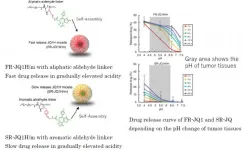(Press-News.org) A study by researchers at William & Mary's Virginia Institute of Marine Science suggests that continued warming of Atlantic coastal waters may enhance the spread of invasive blue catfish within the Chesapeake Bay and other estuaries along the U.S. East Coast.
The research, by Drs. Vaskar Nepal and Mary Fabrizio of VIMS, appeared in a recent issue of PLOS ONE. It builds on an earlier study by the two authors showing that blue catfish can better tolerate salinity spikes than most freshwater fishes, and thus may be able to expand their range downstream into mainstem Chesapeake waters, and from there into new Bay tributaries and even Delaware Bay. "Blue cats" were introduced to tidal freshwater stretches of the James, York, and Rappahannock rivers during the 1970s and 1980s to enhance recreational fisheries. They feed on vegetation, mollusks, and fishes, often out-competing native species such as white catfish. Their continued spread thus concerns fisheries managers.
The pair conducted their latest study to investigate the combined, long-term effects of salinity and temperature on catfish health and behavior. Nepal, now a post-doctoral research associate at VIMS, says "By manipulating both factors, we were able to address an important knowledge gap and more closely simulate real-world conditions, where salinity and temperature can and do vary over a range of time scales." East Coast estuaries are warmer and typically saltier during summer; colder and fresher during winter and spring. Their heat and salt content can also vary on shorter time-scales during rainy spells, drought, heat waves, or cold snaps.
The researchers studied the combined effects of salinity and temperature by monitoring the health and behavior of 160 juvenile blue catfish divided among two duplicate sets of eight tanks, each set with four levels of salinity (1, 4, 7 or 10 practical salinity units) and two temperature levels (54° F or 72° F). The salinity treatments represent a range from largely fresh (1 psu) to moderately brackish (10 psu) waters, as found in many Bay tributaries. The temperatures are typical of Chesapeake Bay waters occupied by blue catfish during winter and spring. All tanks and fish were monitored inside the VIMS Seawater Research Laboratory for more than three months.
Nepal and Fabrizio assessed how the eight salinity and temperature combinations affected the fish's growth, body condition, body composition, and food consumption. Their results show that warmer water temperature has a positive effect on the biology of blue catfish under salinity conditions often encountered in estuarine waters.
"At salinities up to 7 psu, mean growth rate, body condition, and consumption rates were all higher at 72 degrees than at 54 degrees," says Nepal. "We measured the highest growth and body condition at 72 degrees and 4 psu." Warmer, fresher waters--as projected by climate models in the future Bay due to increased trapping of heat and enhanced precipitation--would thus appear to favor the spread and establishment of blue cats.
The average rate at which blue cats consumed their food did decline significantly at salinities greater than 9 psu. This was not unexpected, as that is the internal salinity of most freshwater fishes. When bathed in waters saltier than their own internal tissues, fish must expend considerable energy to prevent osmosis from driving bodily fluids into the surrounding water. That extra energy expenditure decreases the fish's overall health. In Nepal and Fabrizio's experiments, blue catfish held at 10 psu showed low consumption rates, slow growth, and low body condition.
Fabrizio, a professor and chair of the Fisheries Science Department at VIMS, says "Habitats with salinities higher than 9 psu likely will not support the full life-cycle of blue catfish, but the fish may use salinities up to 10 psu for foraging, dispersal, and even growth."
"Many brackish habitats along the U.S. East Coast may thus be vulnerable to invasion by blue catfish," says Nepal, "particularly given increasing temperatures due to climate warming."
"Given these findings," he adds, "state and regional management agencies should pay close attention to habitats at these salinities, especially in areas that provide nursery habitat for native species of conservation concern."
Sea-level rise promises one bright spot for those concerned with the spread of blue catfish. "Our rising seas are projected to bring saltier waters farther up our estuaries and tributaries," says Nepal. "This salinity intrusion may serve to limit dispersal between tributaries and form discrete subpopulations of blue catfish that are only connected during periods of high freshwater flow."
INFORMATION:
Researchers at the Lady Davis Institute (LDI) at the Jewish General Hospital have discovered that increased levels of the protein OAS1 are associated with reduced mortality and less severe disease requiring ventilation among patients with COVID-19. Using drugs that boost OAS1 levels could be explored to try to improve these outcomes. The findings are published today in Nature Medicine.
"Our analysis shows evidence that OAS1 has a protective effect against COVID-19 susceptibility and severity," explains Dr. Brent Richards, a senior investigator at the LDI's Centre for Clinical Epidemiology and Professor of Medicine, Human Genetics, Epidemiology and Biostatistics at McGill University. "This is a very ...
A new study using leading edge technology has shed surprising light on the ancient habitat where some of the first dinosaurs roamed in the UK around 200 million years ago.
The research, led by the University of Bristol, examined hundreds of pieces of old and new data including historic literature vividly describing the landscape as a "landscape of limestone islands like the Florida Everglades" swept by storms powerful enough to "scatter pebbles, roll fragments of marl, break bones and teeth."
The evidence was carefully compiled and digitised so it could be used to generate for the first time ...
NEW YORK, NY (Feb. 26, 2021)--People who took statins to lower cholesterol were approximately 50% less likely to die if hospitalized for COVID-19, a study by physicians at Columbia University Vagelos College of Physicians and Surgeons and NewYork-Presbyterian has found.
"Our study is one of the larger studies confirming this hypothesis and the data lay the groundwork for future randomized clinical trials that are needed to confirm the benefit of statins in COVID-19," says Aakriti Gupta, MD, a cardiologist at NewYork-Presbyterian/Columbia University Irving Medical Center and one of the co-lead authors of the study.
"If their beneficial effect bears out in randomized clinical trials, statins could potentially prove to be a low-cost and effective therapeutic ...
Ithaca, NY--Famous for their uncanny ability to imitate other birds and even mechanical devices, researchers find that Australia's Superb Lyrebird also uses that skill in a totally unexpected way. Lyrebirds imitate the panicked alarm calls of a mixed-species flock of birds while males are courting and even while mating with a female. These findings are published in the journal Current Biology.
"The male Superb Lyrebird creates a remarkable acoustic illusion," says Anastasia Dalziell, currently a Cornell Lab of Ornithology Associate and recent Cornell Lab Rose Postdoctoral Fellow, now at the University of Wollongong, Australia. "Birds gather in mobbing flocks and the ruckus they make is a potent cue of a predator nearby. The ...
A common barnacle could be used to help trace missing persons lost at sea, according to research by UNSW Science.
Researchers from the Centre for Marine Science and Innovation have developed an equation that can estimate the minimum time an object has spent drifting at sea by counting the number of Lepas anserifera attached to the object.
They also developed an equation which can help plot possible drift paths of a missing boat.
"We saw this opportunity that Lepas could possibly fill in this gap in that marine forensic process and possibly contribute (to finding missing people)," study lead author Thomas ...
February 26, 2021 - Kawasaki, Japan: The Innovation Center of NanoMedicine (Director General: Prof. Kazunori Kataoka, Location: Kawasaki in Japan, Abbreviation: iCONM) reported in ACS Nano (Impact Factor: 14.588 in 2019) together with the group of Prof. Yu Matsumoto of Otorhinolaryngology and Head and Neck Surgery (Prof. Tatsuya Yamasoba) and the group of Prof. Horacio Cabral of the Department of Bioengineering (Prof. Ryo Miyake) in the University of Tokyo that the efficacy of polymeric nano-micelles with different drug activation profile depends on the expression level of c-Myc, one of the major proto-oncogene, has been developed. See: https://pubs.acs.org/doi/10.1021/acsnano.1c00364
It ...
Preterm labor comprises 12.7% of all pregnancies. Although the overall rate of pregnancy is decreasing, the occurrence of premature birth due to preterm labor in south korea has been increasing over the past 7 years. Not only is preterm birth accountable for about a half of all neonatal mortality cases, the neurological deficits in surviving premature infants often lead to problems later in life, such as developmental disorders and respiratory complications. Currently, preterm labor is detected only when expecting mothers experience abnormal symptoms, or when they undergo a routine test like abdominal ultrasound or a laboratory test for ...
Researchers at Oregon Health & Science University have demonstrated a new method of quickly mapping the genome of single cells, while also clarifying the spatial position of the cells within the body.
The discovery, published in the journal Nature Communications, builds upon previous advances by OHSU scientists in single-cell genome sequencing. The study represents another milestone in the field of precision medicine.
"It gives us a lot more precision," said senior author Andrew Adey, Ph.D., associate professor of molecular and medical genetics in the OHSU School of Medicine. "The single-cell aspect gives us the ability to track the molecular changes within each cell type. Our new study also allows the capture of where those ...
If you've ever watched Planet Earth, you know the ocean is a wild place to live. The water is teaming with different ecosystems and organisms varying in complexity from an erudite octopus to a sea star. Unexpectedly, it is the sea star, a simple organism characterized by a decentralized nervous system, that offers insights into advanced adaptation to hydrodynamic forces--the forces created by water pressure and flow.
Researchers from the USC Viterbi School of Engineering found that sea stars effectively stay attached to surfaces under extreme hydrodynamic loads by altering their shape. The researchers, including the Henry Salvatori Early Career Chair in Aerospace and Mechanical Engineering Mitul Luhar and doctoral ...
Epilepsy is one of the most common neurological conditions, affecting more than 65 million worldwide. For those dealing with epilepsy, the advent of a seizure can feel like a ticking time bomb. It could happen at any time or any place, potentially posing a fatal risk when a seizure strikes during risky situations, such as while driving.
A research team at USC Viterbi School of Engineering and Keck Medicine of USC is tackling this dangerous problem with a powerful new seizure predicting mathematical model that will give epilepsy patients an accurate warning five minutes to one hour before they are likely to experience a seizure, offering enhanced freedom for the patient and cutting the need for medical intervention.
The research, ...





